In the evolving landscape of pet care, slow feeder dog bowls emerge as a pivotal innovation aimed at enhancing the well-being of canines. These specialized bowls are designed to moderate a dog’s eating pace, addressing common issues such as bloat, obesity, and indigestion that stem from rapid consumption. By integrating physical barriers, these bowls encourage pets to eat slowly, turning mealtime into a challenging activity that benefits their physical and mental health. As pets increasingly become integral members of the family, the demand for products that contribute to their longevity and happiness continues to rise, making slow feeder dog bowls a key area of interest for those aiming to meet the evolving needs and preferences of pet owners.
Table of Contents
1. The pulse of the 2024 market
2. Crafting your choice
3. The cream of the crop: Standout bowls of 2024
4. Final takeaways
The pulse of the 2024 market
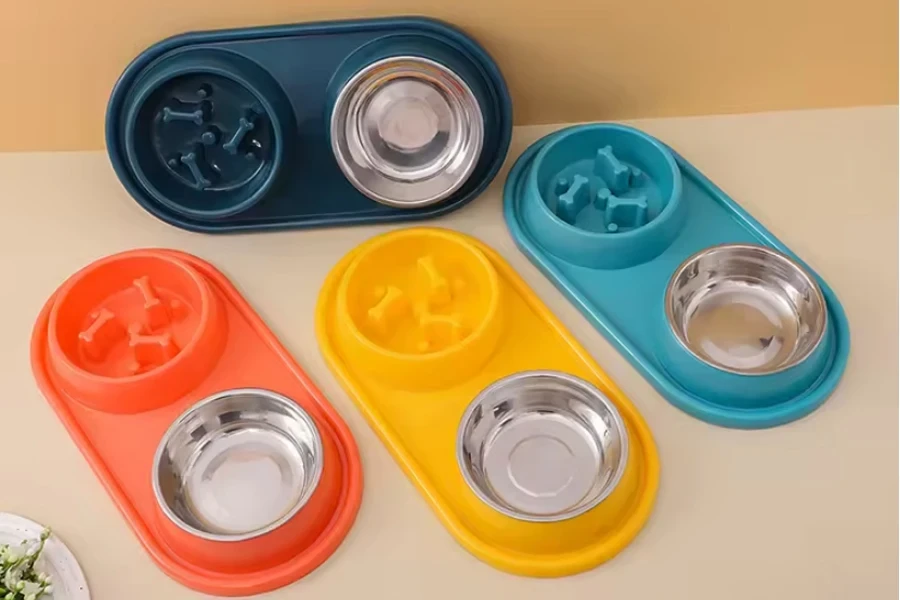
The significance of slow feeder dog bowls in the realm of pet care cannot be overstated, revolutionizing how canines engage with their meals. These innovative bowls are designed not merely as containers for dog food but as tools to enhance the feeding experience of pets, catering to a variety of needs and preferences. The market for slow feeder dog bowls is witnessing a significant evolution as 2024 approaches, shaped by emerging trends and a deeper understanding of consumer preferences. This section delves into what’s currently shaping the future of pet feeding solutions and how consumer desires are influencing the innovation and design of slow feeder dog bowls.
Discovering the variety: Types and their perks
Exploring slow feeder dog bowls beyond the material classification reveals a world of designs each tailored to challenge and engage dogs differently during mealtime. These designs not only slow down the eating pace but also stimulate a dog’s mental faculties and make each meal a rewarding activity. Here’s an insight into various types of slow feeder dog bowls based on their design and functionality, along with the unique benefits they offer:
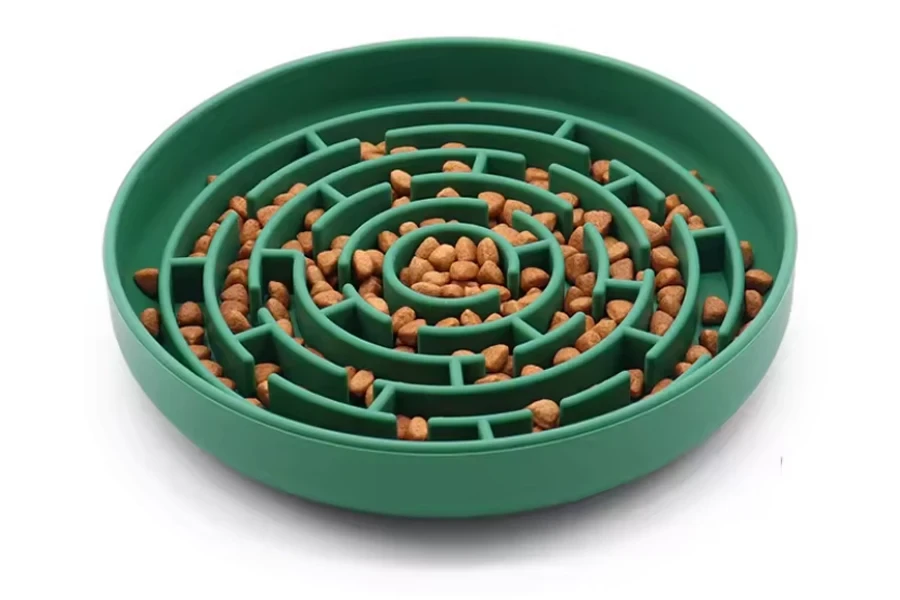
Maze Designs: Maze-designed slow feeders are among the most common, featuring complex pathways that force dogs to navigate their way to their food. This design significantly slows down eating speed, reducing the risk of bloat and improving digestion. The intricate patterns also serve as a mental workout for dogs, keeping their minds engaged and entertained during mealtime.
Spiral and Ridge Patterns: Bowls with spiral or ridge patterns are slightly less complex than maze designs, making them a good middle ground for dogs who are new to slow feeders or those that get easily frustrated. These patterns slow down eating by creating physical barriers to direct access, encouraging dogs to eat around the spirals or ridges, promoting better chewing and slower ingestion.
Bump and Nodule Structures: Featuring raised bumps or nodules across the bowl’s surface, this type of slow feeder is effective at extending mealtime for rapid eaters by obstructing direct access to large portions of food. The varied heights and sizes of the bumps stimulate a dog’s problem-solving skills as they work to retrieve their food, enhancing mental stimulation.
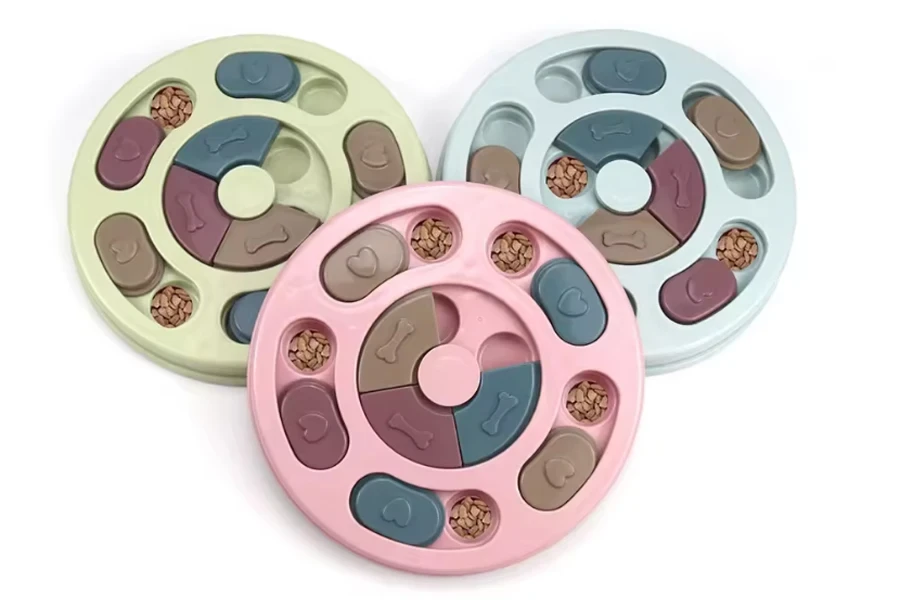
Funnel and Tower Centers: Some slow feeder bowls incorporate a central tower or funnel that dogs must eat around, significantly limiting the amount of food they can access in one go. This design is particularly beneficial for extremely fast eaters as it maximizes the duration of mealtime and encourages meticulous eating habits.
Adjustable Difficulty Feeders: Adjustable slow feeders allow customization of the feeding challenge according to a dog’s skill level or the owner’s preference. This adaptability makes them suitable for a wide range of dogs, from beginners to those accustomed to slow feeders. Owners can increase the difficulty as their dog becomes more adept at navigating the bowl, ensuring continued mental engagement and slow eating.
Interactive Puzzle Feeders: Taking slow feeding to the next level, interactive puzzle feeders combine the benefits of a slow feeder with the mental stimulation of a puzzle toy. These feeders require dogs to solve puzzles to access their food, significantly enriching their mental and physical stimulation. They are particularly useful for dogs that need additional cognitive challenges and can help alleviate boredom.
Each type of slow feeder dog bowl is designed with a specific purpose in mind, whether it’s to slow down eating, provide mental stimulation, or both. The choice of bowl can depend on the dog’s eating style, the level of challenge desired, and the goal of incorporating more interactive mealtime routines. By carefully selecting the appropriate design, owners can significantly enhance their dog’s overall health and well-being.
What’s hot: Trends shaping the future
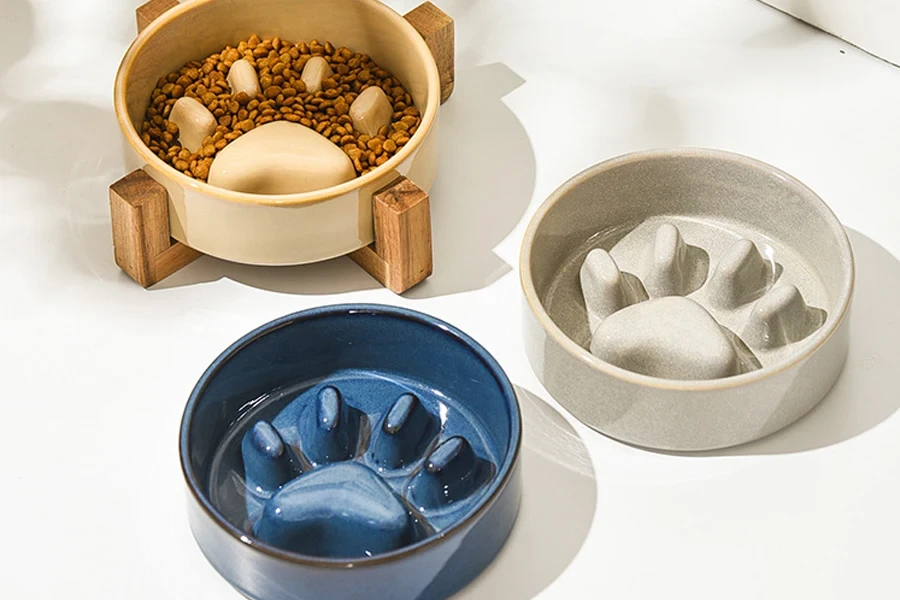
The slow feeder dog bowl market is currently riding the wave of several key trends. Firstly, there’s a growing emphasis on integrating technology into pet care products. Smart slow feeder bowls equipped with RFID technology or IoT connectivity are gaining traction. These bowls can monitor a dog’s eating speed, quantity, and schedule, providing pet owners with actionable insights to optimize their pet’s health.
Sustainability is another trend making its mark. As consumers become more environmentally conscious, there’s a surge in demand for eco-friendly materials. Slow feeder bowls made from biodegradable or recycled materials are becoming popular choices among environmentally conscious pet owners.
Moreover, customization and personalization are becoming increasingly important. Pet owners are looking for products that can be tailored to their pet’s specific needs, including adjustable difficulty levels in slow feeder bowls and designs that cater to different breeds or sizes, ensuring that every dog has a bowl that suits its eating habits perfectly.
In the eyes of the beholder: Understanding buyer desires
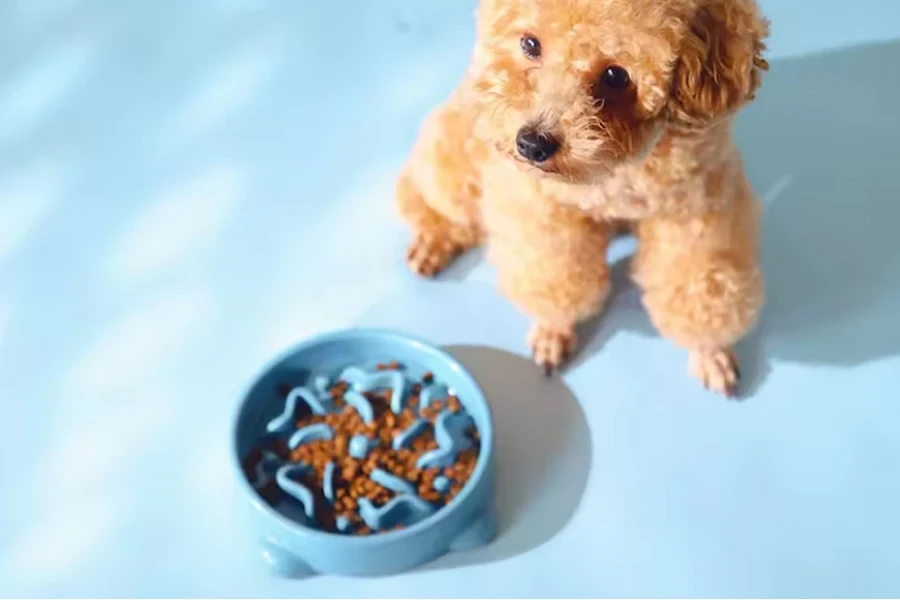
Consumer preferences in the slow feeder dog bowl market are as diverse as the pets themselves. One clear desire is for products that offer more than just functionality. Pet owners are looking for bowls that blend seamlessly with their home décor, indicating a preference for aesthetically pleasing designs alongside practical utility.
Health and safety concerns also play a pivotal role in shaping buyer decisions. Products made from non-toxic, BPA-free materials are preferred to ensure that pets aren’t exposed to harmful substances during mealtime. Additionally, ease of cleaning is a practical aspect that consumers are prioritizing, with dishwasher-safe options being particularly favored for their convenience.
Finally, the value of mental stimulation is being recognized more than ever. Pet owners are not just looking for bowls that slow down their pet’s eating; they want products that mentally engage their dogs, turning mealtime into an enriching experience. This has led to an increased interest in slow feeder bowls with complex designs that challenge pets and stimulate their problem-solving skills.
As the 2024 market unfolds, these trends and consumer preferences are guiding manufacturers towards creating innovative, sustainable, and user-friendly slow feeder dog bowls. The focus is on meeting the needs of modern pet owners who view their pets as family members and are willing to invest in products that enhance their pets’ health and happiness.
Crafting your choice
Selecting the ideal slow feeder dog bowl for a pet involves careful consideration of materials and design to ensure both durability and a match with the dog’s eating style and size.
A material world: What’s your bowl made of?

Slow feeder dog bowls are ingeniously designed to curb the speed at which dogs consume their meals, thereby promoting healthier eating habits. These bowls are available in various types, each offering unique benefits to cater to the diverse needs of canine companions. Here’s a closer look at the primary types of slow feeder dog bowls and the perks associated with each:
Plastic Slow Feeder Bowls: Plastic slow feeders are highly popular due to their affordability and variety in designs and colors. These bowls often feature intricate patterns and mazes that mentally stimulate dogs by challenging them to navigate their meals, which can significantly slow down their eating pace. They’re lightweight and usually dishwasher safe, making them convenient for everyday use. However, when opting for plastic, it’s crucial to select bowls that are BPA-free to ensure they don’t leach harmful chemicals.
Stainless Steel Slow Feeder Bowls: Stainless steel bowls are lauded for their durability and ease of cleaning. Unlike plastic, they’re resistant to chewing and won’t harbor bacteria, making them a hygienic option for feeding pets. While the designs in stainless steel may not be as varied or intricate as in plastic bowls, they still effectively slow down eating speeds and are an excellent choice for dogs that might try to chew on plastic. Additionally, stainless steel bowls are typically heavier, reducing the likelihood of the bowl being tipped over during mealtime.
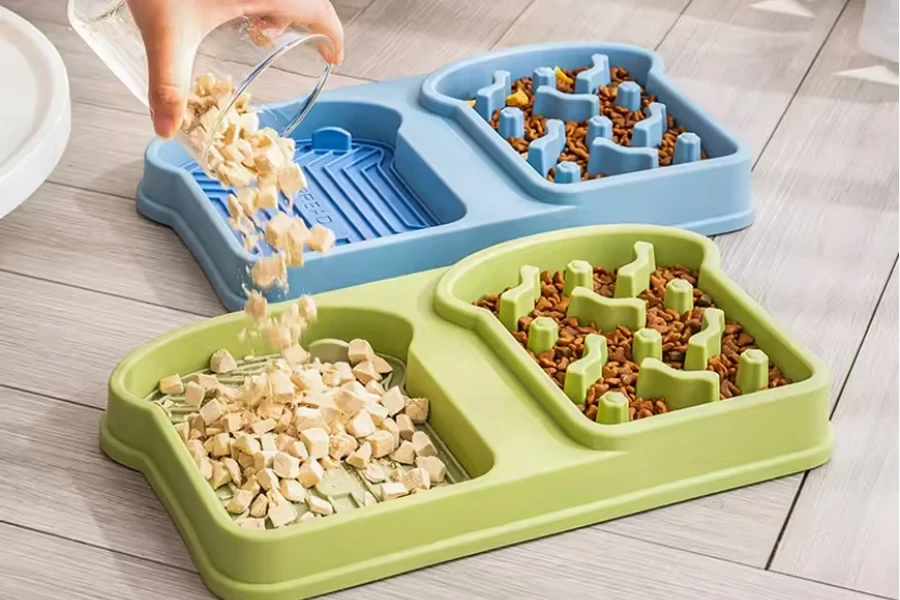
Ceramic Slow Feeder Bowls: Ceramic slow feeders combine functionality with aesthetics, offering a stylish addition to any pet feeding area. Like their stainless steel counterparts, ceramic bowls are easy to clean, durable, and great for pets that may have allergies to plastics. The weight of ceramic helps keep the bowl in place, and while the range of designs might be more limited than plastic, they provide enough of a challenge to slow down fast eaters. It’s important to ensure that the ceramic used is lead-free and glazed to prevent chipping and maintain hygiene.
Silicone Slow Feeder Mats: Silicone slow feeder mats offer a flexible alternative to traditional bowls. These mats can be spread flat on the floor, making them suitable for dogs that prefer a more natural eating posture or those with neck strain. The mats have raised patterns that dogs need to work around to access their food, effectively slowing down their eating pace. Silicone mats are non-slip, can be easily rolled up for storage or travel, and are dishwasher safe for easy cleaning. They’re particularly beneficial for dogs that push their bowls around, as the mat stays firmly in place.
Choosing the right type of slow feeder dog bowl depends on a dog’s specific needs, eating habits, and the owner’s preference for maintenance and aesthetics. Regardless of the type, the primary goal remains to encourage slower eating for a healthier, more digestible meal experience.
The perfect fit: Design meets dog
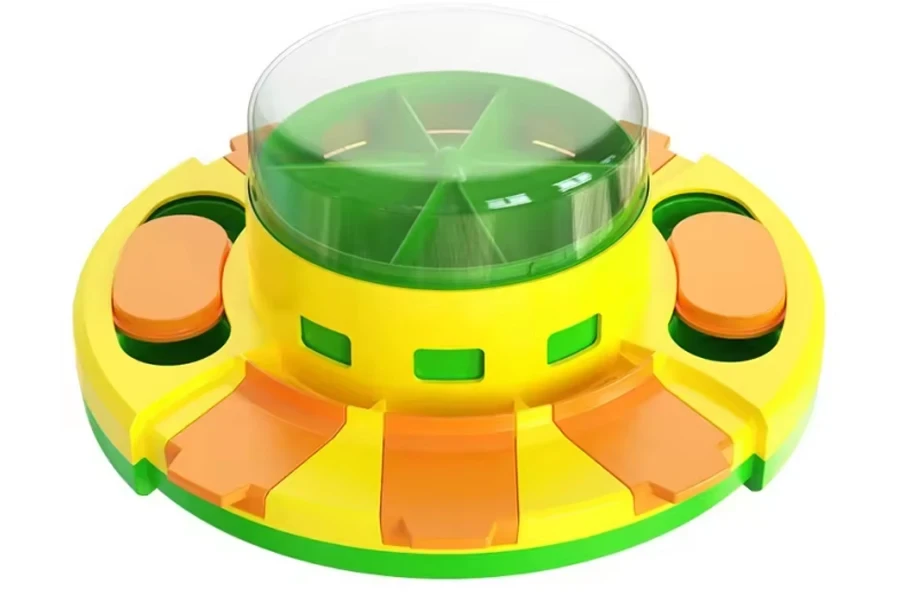
Matching the right slow feeder dog bowl to a dog’s specific breed and eating habits is crucial for maximizing the benefits of slow feeding while ensuring the dog remains engaged and stress-free during mealtime. Here’s a comprehensive guide on how to select the most suitable slow feeder bowl for various dog breeds and their unique eating habits:
Assess the dog’s eating habits
The first step in choosing the right slow feeder is observing how the dog eats.
Fast Eaters: Dogs that tend to gulp their food down rapidly may need a bowl with a more complex maze or pattern. This increases the difficulty level, forcing them to slow down and chew their food properly, which aids in digestion and prevents bloat and chocking. For example, the Northmate Green Feeder transforms eating into a hunt for food amidst blades of grass, ideal for dogs that need a high level of challenge to slow their eating.
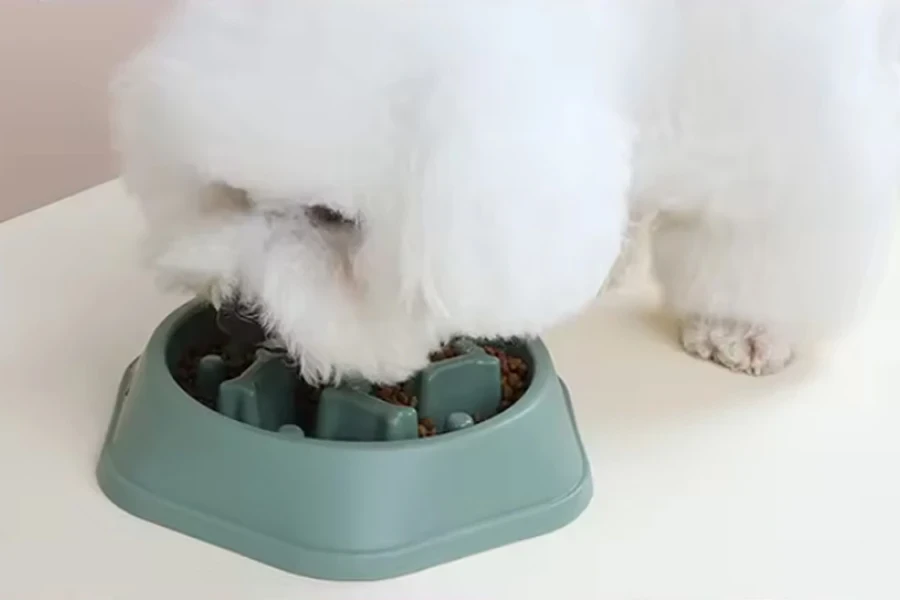
Moderate Eaters: For dogs that don’t eat particularly fast but could still benefit from a slower pace, a bowl with a simple spiral or wave pattern may suffice. This gently encourages them to eat more slowly without causing frustration or disinterest. The Siensync Fun Feeder, with its spiral grooves, gently slows down dogs who don’t gulp their food but could still enjoy a slower feeding time for enhanced digestion.
Picky Eaters: Dogs that are less enthusiastic about their meals or tend to eat very slowly might be discouraged by overly complex bowls. Opt for a design that offers a mild challenge but still allows easy access to food to encourage engagement without deterring them from eating.
Consider the size and shape of the dog
The physical attributes of the dog—such as size, breed, and muzzle shape—play a crucial role in selecting an appropriate bowl design.

Large Breeds: For larger dogs with wider snouts, such as Labradors or German Shepherds, choose slow feeder bowls with larger spaces between obstacles. This ensures they can comfortably fit their mouths around the food without frustration or discomfort.
Small Breeds: Small breeds like Chihuahuas or Yorkies benefit from bowls with more compact and shallower designs. These designs prevent them from feeling overwhelmed and make it easier for them to reach the food.
Flat-Faced Breeds: Breeds with short snouts, such as Bulldogs or Pugs, require specially designed bowls with very shallow obstacles. These allow them to access the food without straining their faces or necks, providing a comfortable and effective slow feeding solution.
Adaptability and Adjustable Difficulty: Some slow feeder bowls come with adjustable features to modify the difficulty level. This can be particularly useful for dogs that are initially resistant to slow feeding, as it allows them to gradually adapt to the challenge.
When selecting a slow feeder dog bowl, it’s essential to observe your dog’s behavior during mealtime to understand their needs better. By choosing a bowl that aligns with their breed characteristics and personal eating habits, you ensure a more enjoyable and health-promoting dining experience for your furry friend.
The cream of the crop: Standout bowls of 2024
Based on performance and user reviews, several slow feeder dog bowls have risen above the competition in 2024. While specific models and brands continuously evolve, the criteria for what makes a slow feeder stand out remain consistent: effectiveness in slowing down eating, durability, ease of cleaning, and positive pet engagement.
Frisco Bone Shaped Ridges Slow Feed Bowl
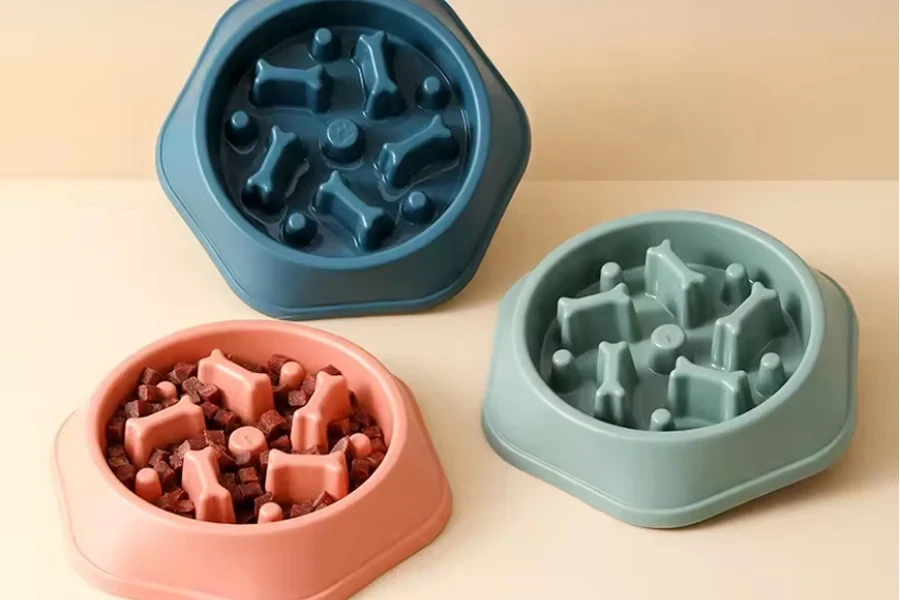
The Frisco Bone Shaped Ridges Slow Feed Bowl offers an affordable and practical solution for pet owners looking to introduce their dogs to the concept of slow feeding. With its bone-shaped ridges and obstacles, this bowl effectively slows down meal times, helping to prevent the risks associated with fast eating such as bloat and indigestion. The inclusion of a skid-proof bottom and a convenient side notch makes this bowl easy to handle and stable during use. It’s designed to hold up to three cups of food, making it suitable for a variety of dog sizes, and its simplicity is perfect for pets who are new to slow feeders. Additionally, the bowl’s top-rack dishwasher-safe feature ensures easy cleanup. While its basic design may not challenge more experienced dogs, it’s an excellent starter bowl for those exploring slow feeding for the first time.
Leashboss Flat Face Feeder
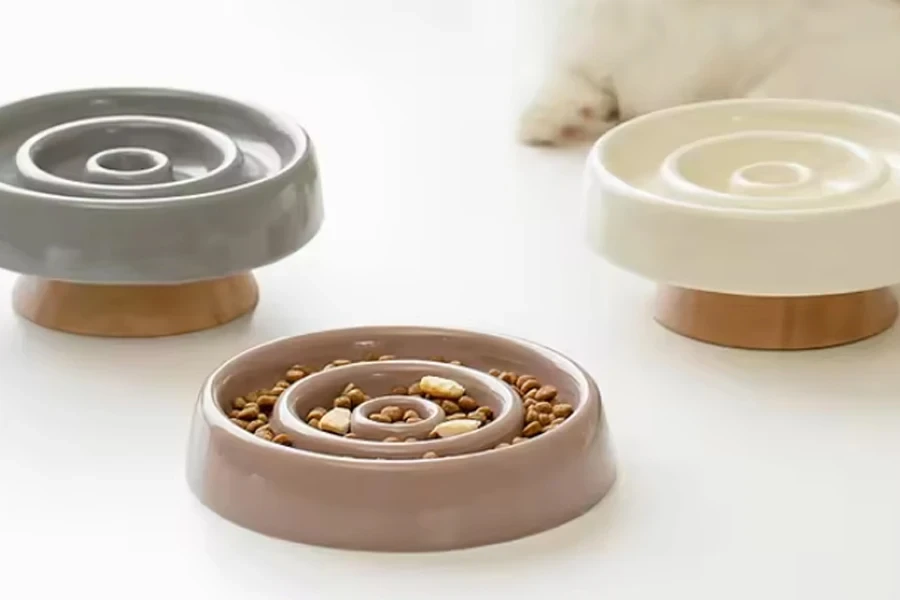
The Leashboss Flat Face Feeder is thoughtfully designed to cater to the unique needs of flat-faced breeds, offering a tilted and shallow-grooved feeding solution that allows easier access to food without the frustration common with deeper bowls. This design ensures that breeds like pugs and bulldogs can comfortably reach their meals, promoting slower eating without the added difficulty of navigating deep grooves. Made from BPA, PVC, and phthalate-free plastic, this feeder prioritizes your pet’s safety and is easy to clean, being dishwasher safe. Its stability is enhanced with non-skid rubber feet, preventing the bowl from sliding across the floor during meal times. Available in two colors, it also features a convenient handle for easy lifting, although it comes in only one size. The Leashboss Flat Face Feeder addresses a specific challenge faced by certain dog breeds, making it an indispensable tool for pet owners seeking a slow feeding solution that is both effective and considerate of their dog’s physical attributes.
Mr. Peanut’s Stainless Steel Interactive Slow Feed Dog Bowl with a Silicone Base
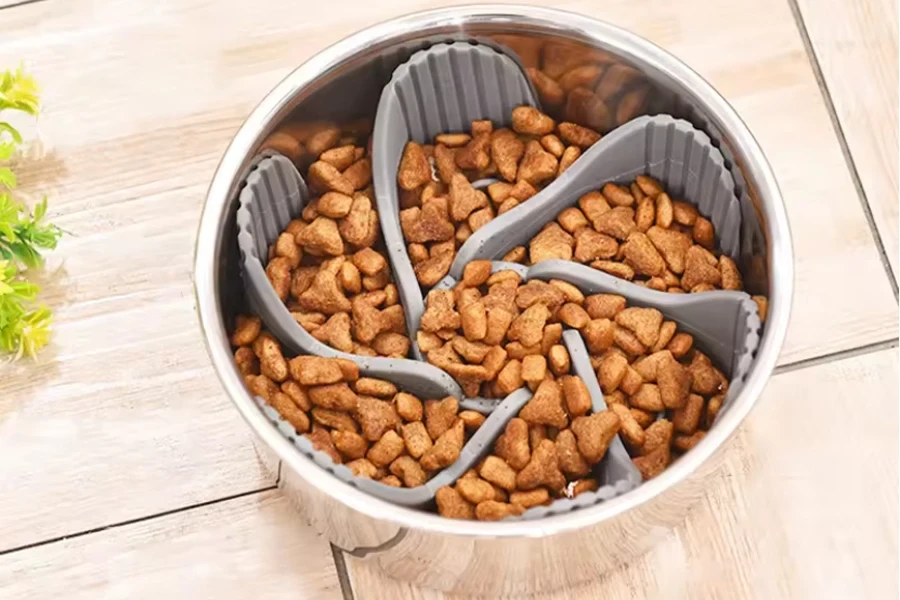
Mr. Peanut’s Stainless Steel Interactive Slow Feed Dog Bowl integrates functionality with a thoughtful design to slow down dogs who eat too quickly, featuring raised columns within the bowl that create an interactive mealtime challenge. This design encourages dogs to navigate around the obstacles, effectively slowing their eating pace and promoting digestive health. The use of stainless steel ensures durability and ease of cleaning, while the silicone base provides stability, preventing the bowl from sliding on the floor. Suitable for both dry and wet food, this bowl offers versatility in feeding options, catering to a wide range of dietary preferences. The combination of a durable material, a non-slip base, and an engaging design makes Mr. Peanut’s bowl a standout option for pet owners looking to enhance their dog’s eating experience with a slow feeder that’s built to last.
Neater Pet Brands Hammered Stainless Steel Slow Feed Bowl
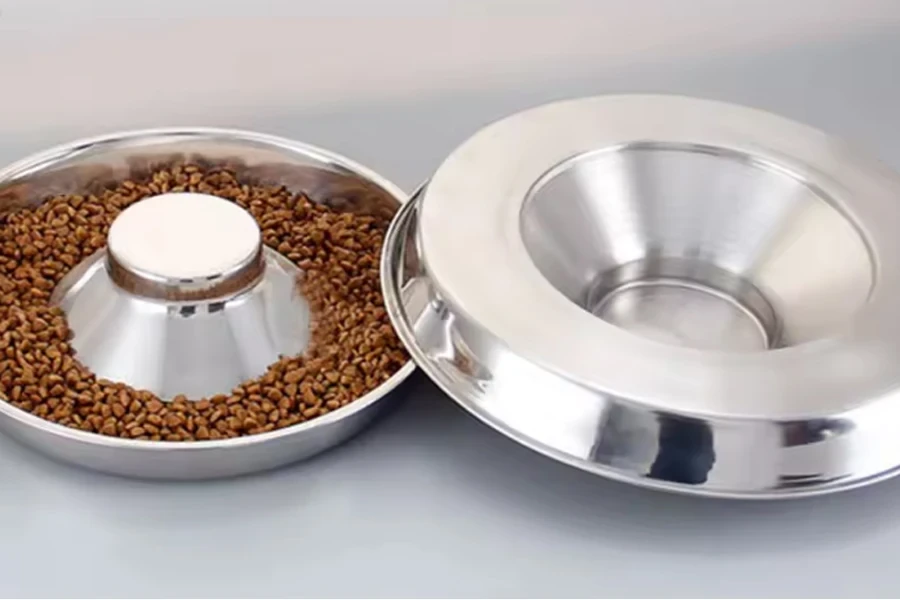
Elegantly designed with a hammered stainless steel finish, the Neater Pet Brands Slow Feed Bowl offers a stylish yet functional approach to slow feeding. The bowl’s aesthetic appeal is matched by its effectiveness in encouraging slower eating through a raised center that presents a gentle challenge to dogs. The inclusion of a non-slip base ensures the bowl remains stable during use, addressing the practical needs of mealtime. Its durability, combined with the ease of cleaning inherent in stainless steel, makes this bowl a preferred choice for pet owners looking for a long-lasting slow feeder that doesn’t compromise on style. This bowl not only slows down the eating process but also adds a touch of sophistication to your pet’s feeding area, making it a unique blend of design and functionality.
Le Tauci Ceramic Slow Feeder Dog Bowl
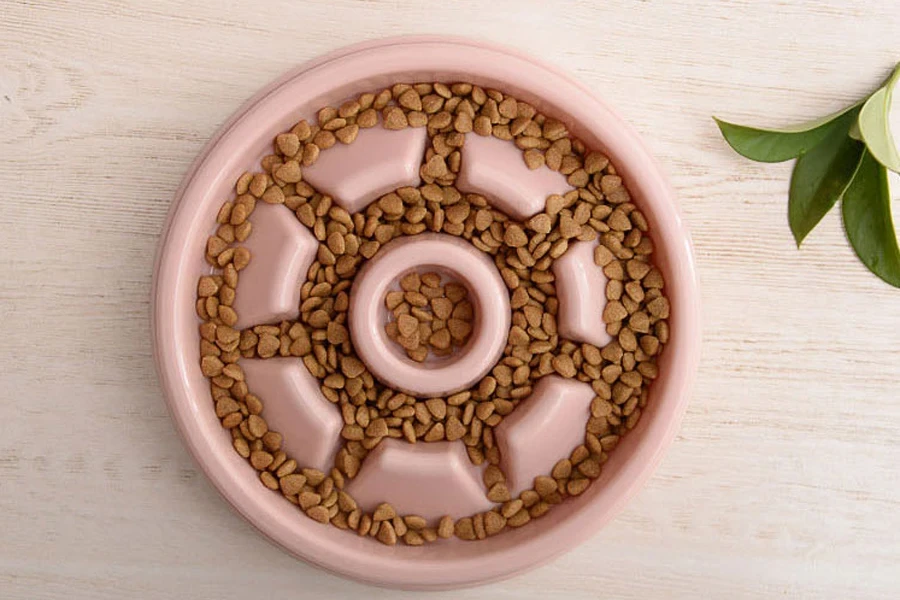
The Le Tauci Ceramic Slow Feeder Dog Bowl is not only functional but also customizable, with three size options and eight color choices to fit your dog’s needs and match your home decor. The variety of internal designs, including vortex, angel, and flower patterns, encourages dogs to eat more slowly by navigating their food through these obstacles. Though its ceramic construction makes it heavier and less portable than other materials, this bowl’s weighted base and non-slip stickers ensure stability. It’s also microwave and dishwasher safe, although hand washing is recommended due to the intricate designs. For dogs that benefit from elevated feeding, there’s an option to purchase a version with a wooden stand, enhancing both the bowl’s functionality and aesthetic appeal.
Outward Hound Fun Feeder Slow Bowl (Flower-Shaped Design)
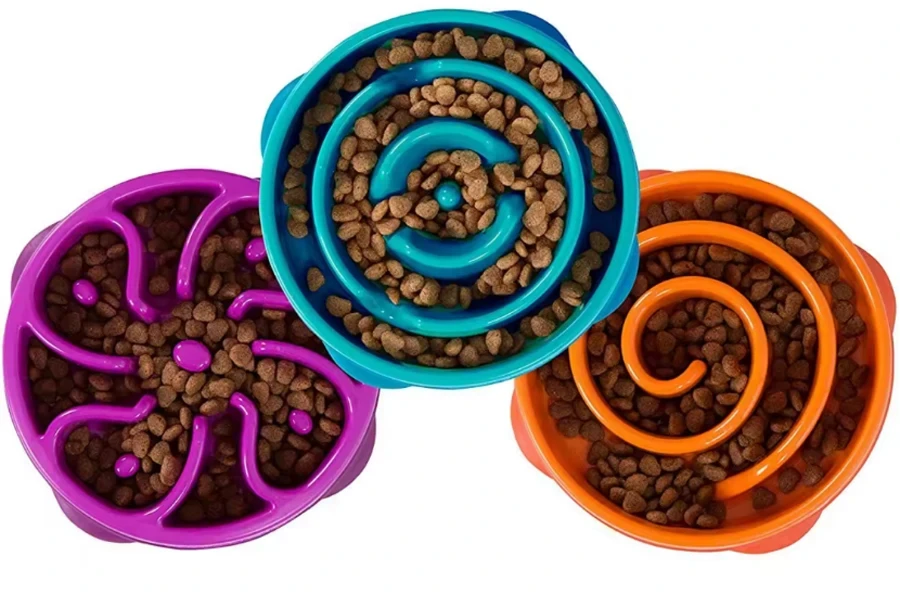
The Outward Hound Fun Feeder Slow Bowl, with its flower-shaped design, is crafted to slow down dogs who eat their meals too quickly, while being less challenging than other models, making it perfect for beginners. This bowl is specifically designed to accommodate dogs that are new to slow feeding, offering a gentler introduction to eating slower through its less intricate swirly, flower-shaped design. It’s an effective choice for pet owners looking to ease their dogs into the concept of slow feeding without causing frustration. Available in three sizes to hold up to four cups of food, this bowl also boasts a non-skid bottom, ensuring it stays in place during mealtime. The use of BPA-, PVC-, and phthalate-free plastic not only guarantees the safety of your pet but also makes it easy to clean, being top-rack dishwasher safe. However, its simplicity might not present a sufficient challenge to dogs already familiar with slow feeders, potentially making it less effective for more experienced pets.
LickiMat Wobble Slow Feeder
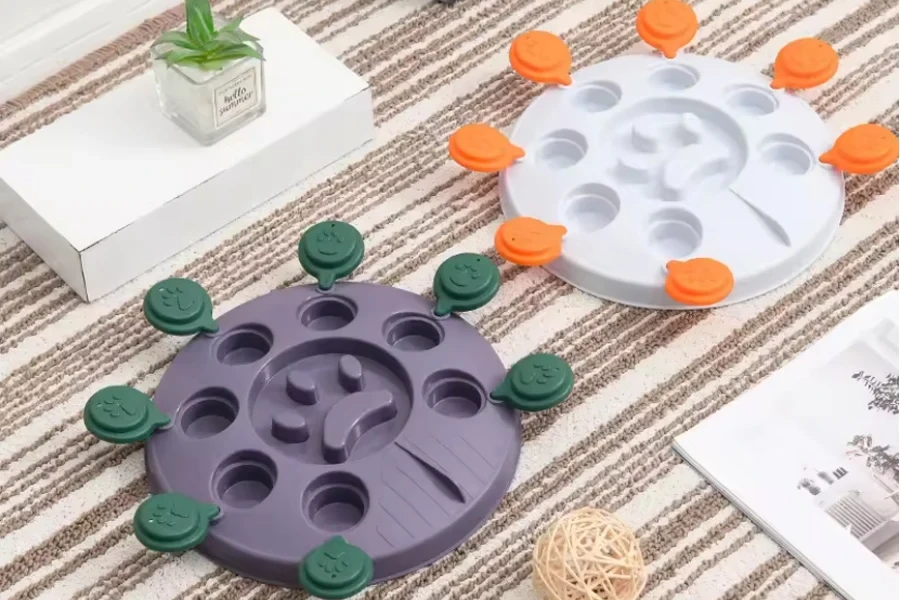
The LickiMat Wobble uniquely combines the functionality of a slow feeder with the entertainment value of a lick mat, offering a novel way to engage your dog during mealtime. By spreading creamy treats into its textured surface and adding kibble or other treats, it turns mealtime into a fun activity that slows down eating and stimulates your dog’s senses. The wobble design adds an extra layer of challenge as dogs work to get their food, engaging their problem-solving skills and prolonging mealtime. Made from natural rubber that’s safe for pets and easy to clean in the dishwasher, this feeder is designed for durability and convenience. However, being available in only one size and color might limit its appeal to some pet owners looking for more customization options. The LickiMat Wobble stands out for its innovative approach to slow feeding, providing both mental stimulation and a practical solution to fast eating.
Each of these products offers a unique take on the slow feeder concept, from the specialized design for flat-faced breeds to durable and interactive options that cater to all dogs. Whether you’re concerned about your pet’s health, their eating habits, or simply looking for a bowl that complements your home decor, these slow feeders provide a range of solutions to enhance your dog’s feeding routine.
Final takeaways
As the landscape of pet care evolves, selecting the right slow feeder dog bowl emerges as a critical decision for enhancing a pet’s health and wellbeing. The journey through understanding material choices, matching designs to a dog’s specific needs, embracing innovative technologies, and recognizing standout models underscores the importance of informed and thoughtful consideration. For industry professionals, offering a selection that caters to the diverse needs of pet owners not only aligns with market trends but also contributes to the overarching goal of improving pet care practices. Through careful selection, the benefits of slow feeding can be fully realized, promoting happier, healthier pets across the board.




